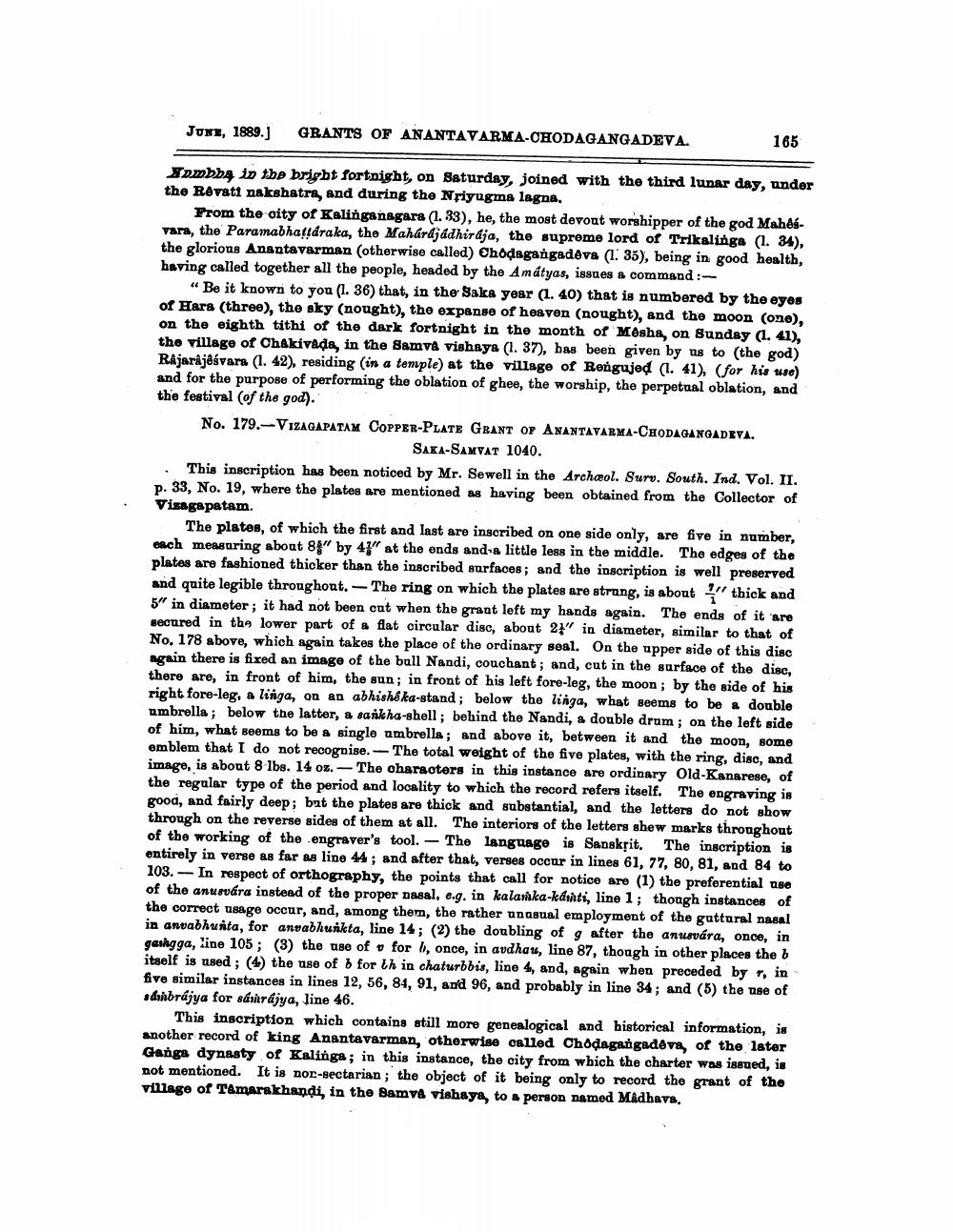________________
JUNE, 1889.] GRANTS OF ANANTAVARMA-CHODAGANGADEVA.
Xumbba in the bright fortnight, on Saturday, joined with the third lunar day, under the Rêvati nakshatra, and during the Nriyugma lagna.
165
From the city of Kalinganagara (1. 33), he, the most devout worshipper of the god Mahesvara, the Paramabhattáraka, the Mahárájádhirája, the supreme lord of Trikalinga (1. 34), the glorious Anantavarman (otherwise called) Chodagangadeva (1. 35), being in good health, having called together all the people, headed by the Amátyas, issues a command:
"Be it known to you (1. 36) that, in the Saka year (1. 40) that is numbered by the eyes of Hara (three), the sky (nought), the expanse of heaven (nought), and the moon (one), on the eighth tithi of the dark fortnight in the month of Mêsha, on Sunday (1. 41), the village of Châkivada, in the Samva vishaya (1. 37), has been given by us to (the god) Rajarajêsvara (1. 42), residing (in a temple) at the village of Bengujed (1. 41), (for his use) and for the purpose of performing the oblation of ghee, the worship, the perpetual oblation, and the festival (of the god)."
No. 179.-VIZAGAPATAM COPPER-PLATE GRANT OF ANANTAVARMA-CHODAGANGADEVA. SAKA-SAMVAT 1040.
This inscription has been noticed by Mr. Sewell in the Archaeol. Surv. South. Ind. Vol. II. p. 33, No. 19, where the plates are mentioned as having been obtained from the Collector of Vizagapatam.
The plates, of which the first and last are inscribed on one side only, are five in number, each measuring about 88" by 47" at the ends and a little less in the middle. The edges of the plates are fashioned thicker than the inscribed surfaces; and the inscription is well preserved and quite legible throughout. - The ring on which the plates are strung, is about thick and 5" in diameter; it had not been cut when the grant left my hands again. The ends of it are secured in the lower part of a flat circular disc, about 2" in diameter, similar to that of No. 178 above, which again takes the place of the ordinary seal. On the upper side of this disc again there is fixed an image of the bull Nandi, couchant; and, cut in the surface of the disc, there are, in front of him, the sun; in front of his left fore-leg, the moon; by the side of his right fore-leg, a linga, on an abhisheka-stand; below the linga, what seems to be a double umbrella; below the latter, a sankha-shell; behind the Nandi, a double drum; on the left side of him, what seems to be a single umbrella; and above it, between it and the moon, some emblem that I do not recognise. The total weight of the five plates, with the ring, disc, and image, is about 8 lbs. 14 oz.- The characters in this instance are ordinary Old-Kanarese, of the regular type of the period and locality to which the record refers itself. The engraving is good, and fairly deep; but the plates are thick and substantial, and the letters do not show through on the reverse sides of them at all. The interiors of the letters shew marks throughout of the working of the engraver's tool. The language is Sanskrit. The inscription is entirely in verse as far as line 44; and after that, verses occur in lines 61, 77, 80, 81, and 84 to 103. In respect of orthography, the points that call for notice are (1) the preferential use of the anusvára instead of the proper nasal, e.g. in kalamka-kamti, line 1; though instances of the correct usage occur, and, among them, the rather unusual employment of the guttural nasal in anvabhunta, for anvabhunkta, line 14; (2) the doubling of g after the anusvára, once, in gashgga, line 105; (3) the use of v for b, once, in avdhau, line 87, though in other places the b itself is used; (4) the use of b for th in chaturbbis, line 4, and, again when preceded by r, in five similar instances in lines 12, 56, 84, 91, and 96, and probably in line 34; and (5) the use of sabrajya for samrajya, line 46.
This inscription which contains still more genealogical and historical information, is another record of king Anantavarman, otherwise called Chodagangadeva, of the later Ganga dynasty of Kalinga; in this instance, the city from which the charter was issued, is not mentioned. It is nor-sectarian; the object of it being only to record the grant of the village of Tamarakhandi, in the Samva vishaya, to a person named Madhava.




